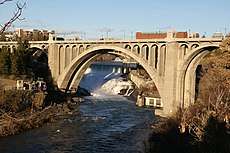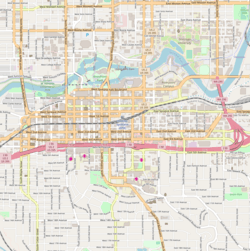Monroe Street Bridge (Spokane River)
The Monroe Street Bridge is a deck arch bridge in the northwestern United States that spans the Spokane River in Spokane, Washington. It was built 109 years ago in 1911 by the city of Spokane,[1] and was designed by city engineer John Chester Ralston, assisted in construction supervision by Morton McCarthy (and by assistant engineers J. F. Greene and P.F. Kennedy) with ornamentation provided by the firm of Kirtland Kelsey Cutter and Karl G. Malmgren as part of Cutter & Malmgren.[5][6]
Monroe Street Bridge | |
|---|---|
 View from southwest in 2007 | |
| Coordinates | 47.6605°N 117.4267°W |
| Crosses | Spokane River |
| Locale | Spokane, Washington, U.S. |
| Characteristics | |
| Design | Decked-arch bridge |
| Material | Reinforced concrete |
| Total length | 896 ft (273 m) |
| Width | 50 ft (15 m) roadway with 9 ft (2.7 m) sidewalks |
| Height | 136 ft (41.5 m) |
| Longest span | 281 ft (85.6 m) |
| History | |
| Construction cost | $500,000 (1911) $18 million (2003–2005 restoration)[1] |
| Opened | November 23, 1911[2][3] |
| Rebuilt | 2003–2005[1][4] |
 Monroe Street Bridge Location in Spokane riverfront area  Monroe Street Bridge Monroe Street Bridge (Washington (state))  Monroe Street Bridge Monroe Street Bridge (the United States) | |
At completion, it was the largest concrete arch bridge in the U.S. and the third longest in the world.[1] After more than ninety years of service, it was closed in January 2003 for restoration and reopened in September 2005.[1]
History
The current bridge of 1911 is the third in this location. The first, a rather rickety wooden structure, was built in 1889. It was closed for a time due to arguments in the city over rights of passage and ownership, and burned down in 1890. The second was a steel bridge that opened in 1892. It vibrated badly and had a noticeable dip in the center. A consultant from the Good Roads Movement considered the bridge unsafe in 1905.[7]
The design of the third bridge was largely copied from the Rocky River Bridge[8][9] in Cleveland, Ohio, but was built one foot (0.3 m) longer to make it the largest concrete arch in the U.S. at the time.[1] In turn, the Rocky River Bridge was modeled after the Walnut Lane Bridge in Philadelphia,[10] which was modeled after the Adolphe Bridge in Luxembourg.[11][12]
The Monroe Street bridge was designed with ornamental features such as bison skulls, covered pavilions, and a chain-link railing motif.[1] The bison skull was an inspiration of P. C. Shine, who had found it in Alberta at Drumheller in the early 1900s. Located just west of the Falls, the bridge runs due north-south and opened on November 23, 1911.[2][3]
20th century modernization
The bridge underwent changes in 1925 and in 1934, and submitted to the modernization of Spokane. The pavilion lamps were converted to electric lighting in 1925, and the electric car railways were removed from the bridge in 1934.[1] Approaching 65 years of service in 1976, the bridge was listed on the National Register of Historic Places.[5]
21st century restoration
By the 1990s, the bridge had deteriorated to the point where rebuilding it was necessary. In January 2003, the bridge was closed for restoration,[13][14] dismantled down to the central arch, and rebuilt faithfully to its original appearance. The bridge was reopened in 2005 on September 17, with new railings and concrete separating the walkways from the road.[1][4][15]
See also



References
- Cannata, Amy (September 17, 2005). "Bridging generations". Spokesman-Review. p. O1.
- "New Monroe Street Bridge ready for dedication". Spokesman-Review. November 22, 1911. p. 6.
- "Bottle broken on kiosk; bridge is really "open"". Spokane Daily Chronicle. November 23, 1911. p. 1.
- Lawrence-Turner, Jody (September 18, 2005). "Bridge Bash". Spokesman-Review. p. A1.
- United States Department of the Interior, National Park Service, National Register of Historic Places Inventory-Nomination Form https://npgallery.nps.gov/pdfhost/docs/NRHP/Text/76001920.pdf
- Arksey, Laura (2006). "Spokane's third Monroe Street Bridge, the historic concrete-arch bridge, opens on November 23, 1911". HistoryLink. Retrieved 2015-02-15.
- History of the city of Spokane and Spokane County, Washington: from its earliest settlement to the present time by Durham, Nelson Wayne, 1859-1938 https://archive.org/details/historyofcityofs01durh
- "Rocky River Bridge – Wikipedia". de.wikipedia.org.
- "Rocky River Bridge, Rocky River Ohio". Historic Structures.
- "Walnut Lane Bridge – Wikipedia". de.wikipedia.org.
- https://de.m.wikipedia.org/wiki/Adolphe-Brücke
- Finkel, Ken (3 October 2016). "The Walnut Lane Bridge: Poetry in Poured Concrete". PhillyHistory Blog.
- Cannata, Amy (January 6, 2003). "Monroe Street Bridge goes out of service today". Spokesman-Review. p. A1.
- Lynn, Adam (January 7, 2003). "First day of closure yields no problems". Spokesman-Review. p. B1.
- Cannata, Amy (2005). "Nearly a Century Old, the Monroe Street Bridge Reopens This Weekend, Sturdy Enough to Carry Us for the Next 75 Years". Spokane.net. Spokane Spokesman-Review. Archived from the original on 2006-10-10. Retrieved 2015-02-15.
Further reading
- "Monroe Street Bridge". City-County of Spokane Historic Preservation Office. 2005. Archived from the original on 2006-09-03. Retrieved 2006-09-12.
- Monroe Street Bridge - the actual (2017) web page of City-County of Spokane Historic Preservation Office
- Moyano, David C., P.E., S.E., M.ASCE; Shrope, Stephen J., P.E., S.E., M.ASCE (2006). "Past Perfect". Civil Engineering Magazine. American Society of Civil Engineers. Archived from the original on 2006-09-09. Retrieved 2006-09-12.
External links
| Wikimedia Commons has media related to Monroe Street Bridge. |